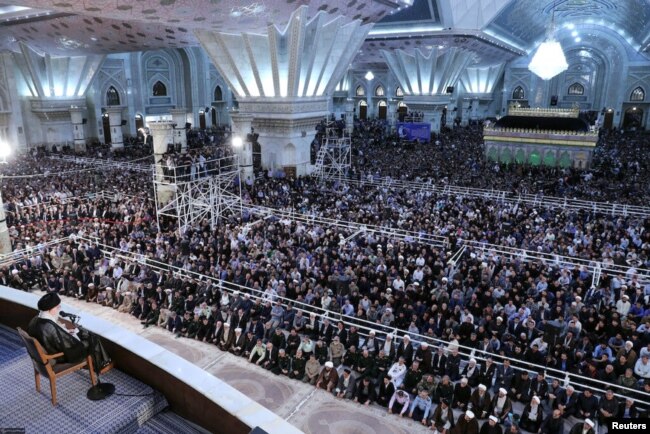VOA – Iran has marked the 30th anniversary of the death of the leader of its Islamic Revolution, Ayatollah Ruhollah Khomeini, by recommitting itself to pursue his bedeviled path of “resistance” against enemies.
Khomeini died of cancer on June 3, 1989, 10 years after leading a revolution that replaced Iran’s monarchy with an enduring theocracy that has become embroiled in regional conflicts, struggled economically under U.S. sanctions and faced more than a year of nationwide anti-government protests.
“In face of hardships, obstacles and tyrannical systems, Imam Khomeini manifested the power of resistance to the entire world,” his successor as supreme leader, Ayatollah Ali Khamenei, told a crowd of thousands who gathered for a Tuesday memorial ceremony at Khomeini’s mausoleum in southern Tehran. “The enemy failed to disrupt [Khomeini’s] calculating capabilities, which were based on the statements of the true religion of Islam.”
Khomeini, born in central Persia in 1902, in about 1922 moved to the Shiite holy city of Qom, where he became a prominent Islamic scholar and outspoken critic of Iran’s monarch, Mohammad Reza Shah Pahlavi. Sent into exile by the shah in 1964, Khomeini spent 14 years in Turkey, Iraq and France before returning to Iran in February 1979 to lead the overthrow of the shah who fled the country weeks earlier.
Khomeini’s decade long rule as Iran’s supreme leader was marked by repression of his political opponents and his stewardship of a brutal 1980-88 war with Iraq. Millions of mourners gathered in Tehran for his funeral on June 4, 1989, the same day that a clerical body named Khamenei as his successor.
Thirty years later, Khomeini’s image is pervasive in Iranian society, with his portrait adorning buildings, public squares and banknotes.
“His legacy is very much alive,” said Clifford May, an American journalist who covered the 1979 revolution from inside Iran and now serves as president of the Foundation for Defense of Democracies, a Washington-based institute. In a VOA Persian interview aired Tuesday, May said Ayatollah Khamenei and Iran’s other senior officials are disciples of Khomeini, committed to continuing his revolution.

“This revolution was meant to establish a state that would have the clerisy, the ayatollahs as its ruling class because they understood Sharia law,” May said. “Khomeini very much disliked democracy. He considered it a form of prostitution in which politicians buy their voters.”
Khomeini instituted the principle of Velayat-e Faqih (the guardianship of the jurist), under which the nation’s power is placed in the hands of a supreme spiritual leader. He agreed to the existence of elected institutions such as the presidency and parliament but retained authority over them.
May said another feature of Khomeini’s legacy is the Islamic Revolution’s goal of spreading itself beyond Iran’s boundaries.
“It was a revolution in Iran, not an Iranian revolution,” he said. “It is meant to establish Islamic power throughout the world and bring down America. That is why they say ‘death’ to America and what they see as the crusader Zionist or Judeo-Christian powers of the world.”
Iran long has spread its influence in parts of the Arab world by providing weapons and funds to proxies such as Lebanese militant group Hezbollah and Palestinian militant groups Hamas and Islamic Jihad in Gaza. All three groups share the ambition of Iran’s rulers to destroy Israel, their main regional foe.
Tehran also has intervened in civil wars in Iraq and Syria in recent years, by sending Iranian troops and Shiite militiamen from various nations to fight Islamic State militants and prop up Syrian President Bashar al-Assad, an Iranian ally. The United States has accused Iranian forces of supplying weapons also to Houthi rebels in Yemen, although Tehran has insisted it provides the Houthis only moral support.
Shiite-majority Iran’s involvement in Middle East conflicts has irked Sunni Arab-led nations who have vowed to resist what they see as an Iranian pursuit of regional hegemony. Some of those nations have been developing informal ties with Israel as they seek its support in countering Iran.
Iranians opposed to spending national resources on foreign conflicts denounced that practice during anti-government street protests that swept Iran from late December 2017 to early January 2018. The demonstrators also denounced Iranian rulers and business leaders whom they accused of oppression, corruption and mismanagement. Nationwide protests have continued over the past year, but sporadically and on a smaller scale.
Iran also has seen its currency slump and its inflation and unemployment rates soar under U.S. sanctions re-imposed by the Trump administration last year. Washington has said it is trying to pressure Tehran into ending perceived malign behaviors, including a suspected pursuit of nuclear weapons. Tehran has said its nuclear program is only for peaceful purposes.
May said the Islamic republic founded by Khomeini still is a powerful force in the region, but is suffering.
“I think [Iran’s] young people would like a better, freer life and believe they could have it, either if this government would change direction, or if they had a very different [kind of] government,” he said. “But I think this regime also knows very well how to deal, in a tough way, with threats [to its authority].”
 Shabtabnews In this dark night, I have lost my way – Arise from a corner, oh you the star of guidance.
Shabtabnews In this dark night, I have lost my way – Arise from a corner, oh you the star of guidance.


